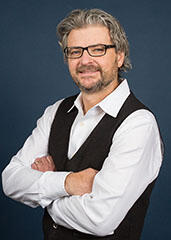 Matt Andrews, Edward S. Mason Senior Lecturer in International Development at Harvard Kennedy School, is the faculty director of the Building State Capability program in the Center for International Development at Harvard and trains students in Problem Driven Iterative Adaptation (PDIA) for solving complex policy and management problems alongside his co-instructor, Salimah Samji. PDIA is a step-by-step approach – developed over years of applied action research - that helps students break down a problem into its root causes, identify entry points, search for possible solutions, take action, reflect upon what has been learned, adapt, and then act again. It is “a dynamic process with tight feedback loops that allows students to build their own solution to a problem.” This approach is most effective, Andrews believes, when “learning happens in groups.”
Matt Andrews, Edward S. Mason Senior Lecturer in International Development at Harvard Kennedy School, is the faculty director of the Building State Capability program in the Center for International Development at Harvard and trains students in Problem Driven Iterative Adaptation (PDIA) for solving complex policy and management problems alongside his co-instructor, Salimah Samji. PDIA is a step-by-step approach – developed over years of applied action research - that helps students break down a problem into its root causes, identify entry points, search for possible solutions, take action, reflect upon what has been learned, adapt, and then act again. It is “a dynamic process with tight feedback loops that allows students to build their own solution to a problem.” This approach is most effective, Andrews believes, when “learning happens in groups.”
Learning effectively through teams
The benefits
While traditional classroom approaches may focus on transmitting information and prompting reflection on new concepts, Andrews notes that policy and management takes place in an “active arena” where team dynamics are crucial to success. Andrews creates opportunities for students to “go out into the real world and try ideas with a group then have them come back into the classroom to have a conversation about what happened.” This “complete cycle of learning” allows for students to compare their experiences and reflect on practice in real time.
“There's learning that happens at the level of the individual. There's learning that happens in the classroom. And then there's learning that happens when people interact with other people, and when they interact in an active sense with the real world. It's not one or the other. It's all those things combined that help people learn how to do applied things.”
The challenges
Many students have experienced negative team dynamics in school or their professional settings, so their collective reaction to learning through a large group work component is typically “a big sigh.” Effective teamwork relies on trust and accountability, which are both difficult to establish quickly.
Takeaways and best practices
-
Facilitate norm setting early.
“Set norms early in the process,” Andrews encourages, noting that he also “facilitates a session early on in which groups generate their own sets of norms and expectations for how they will work together,” rather than providing them with a prescribed set of norms. -
Incorporate collaborative work into class time.
Give students opportunities to work with their team during the course meeting time, so that this logistical barrier is removed, and all students are guaranteed to participate. -
Check in frequently.
To gain insight into group dynamics, Andrews notes that open-ended questions are the most fruitful. Keep the process simple and allow students to feel more agency as team members. Andrews bases check-ins on the following questions: What did you do? What did you learn? What are you struggling with? What's next?
Bottom line
Teams-based learning is an effective tool for applying knowledge to complex real-world situations and gives students an opportunity to develop skills in negotiation and collaboration that are necessary in most professional contexts.
